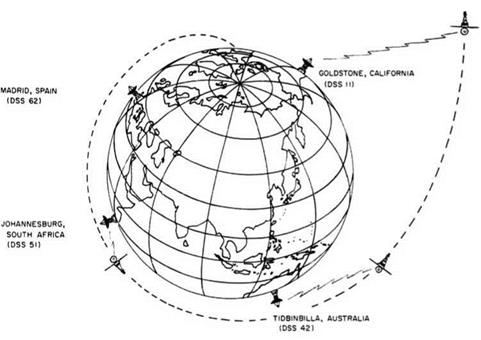DEEP-SPACE TRACKING
When the Advanced Research Projects Agency decided in 1958 that a series of probes should be launched towards the Moon, Eberhardt Rechtin led a team at JPL in the development of radio tracking, telemetry and command facilities. When W. H. Pickering created the Telecommunications Division, he made Rechtin its chief. JPL recognised early on that it would need a world-wide network of antennas to maintain contact with deep-space missions. In late 1958 NASA approved the proposal by JPL to develop the Deep Space Instrumentation Facility. To oversee this activity, Abe
![]() Note that Kuiper, Shoemaker and Urey did not actually originate the experiment.
Note that Kuiper, Shoemaker and Urey did not actually originate the experiment.
|
The Deep Space Instrumentation Facility had large antennas in California, Spain, South Africa and Australia to provide continuous communication with lunar and interplanetary missions. |
Silverstein appointed his assistant for Space Flight Operations, Edmond C. Buckley, who had experience of tracking and instrumentation at the rocket range on Wallops Island.7
As the Ranger project geared up in I960, Rechtin was given the additional role of Program Director for the Deep Space Instrumentation Facility. It was decided to build three stations located approximately 120 degrees apart in longitude to provide a continuous line of sight to a spacecraft in deep space. The main station was built near the Goldstone Dry Lake in the Mojave Desert of California, 160 km east of JPL and on the far side of a range of mountains which would shield the antenna from the ‘noise’ of the coastal cities. The other stations were at the Woomera Test Range in Australia and near Johannesburg in South Africa. Later, a fourth station was added near Madrid in Spain.
Because the antennas had to be both large and fully steerable, it was decided to adapt a radio-telescope design. Although the dish was mounted like a telescope, the steering system was designed to hold the antenna pointing precisely at a spacecraft travelling against the background of stars, rather than to maintain sidereal rate. This
In November 1961, James Webb introduced the Office of Tracking and Data Acquisition at NASA headquarters and made Buckley its Director.
was to be done by having the antenna lock onto the spacecraft’s radio transmission and maximise the received signal strength. A 26-metre-diameter dish was required to track the 3-watt transmitter of the Ranger spacecraft. In addition, a system was installed to enable the antenna to simultaneously send ‘uplink’ at one frequency and to receive ‘downlink’ at another. This allowed not only the position of the spacecraft in the sky to be determined, but also both its range and radial velocity along the line of sight. This data would enable the vehicle’s location and motion in space, together known as its state vector, to be monitored continuously in real-time.
Planning for the Space Flight Operations Centre at JPL began in May I960 and was finished in November I960. As it fell within the remit of the Systems Division, Harris Schurmeier appointed Marshall S. Johnson to supervise its construction in Building 125 of the campus. The Space Flight Operations Centre, together with the terrestrial communications network (initially by voice lines and teletype) to link it to the Deep Space Instrumentation Facility, were declared operational on 4 July 1961.
In February 1961 W. H. Pickering ordered a study of future requirements for flight operations, and the recommendation was to construct a new building specifically for this role. In July, NASA gave the go-ahead. This Space Flight Operations Facility entered service in the summer of 1964. Meanwhile, on 24 December 1963 the Deep Space Instrumentation Facility, the terrestrial communications network and the JPL control centre were integrated under the umbrella of the Deep Space Network.8
Note that the Deep Space Network comprised the Deep Space Instrumentation Facility and Space Flight Operations Facility, it did not supersede them.











